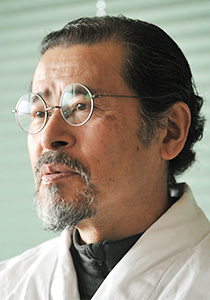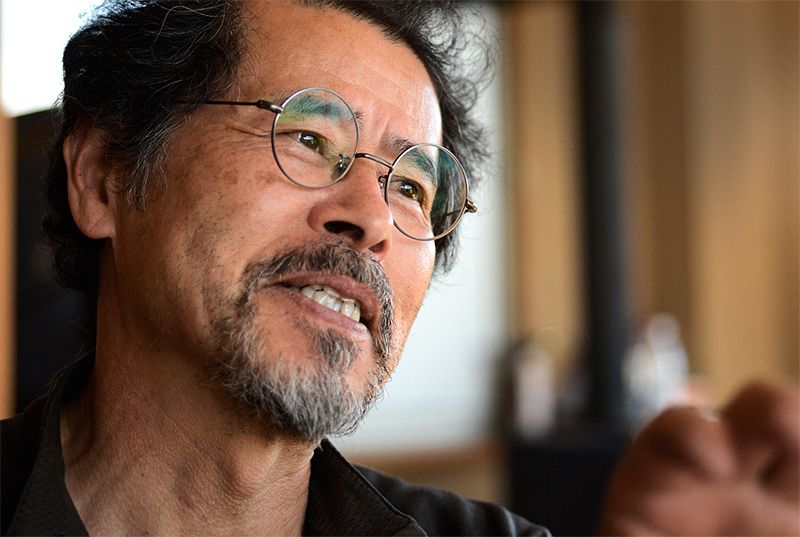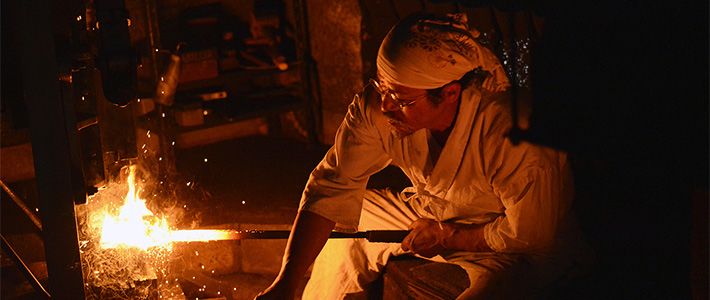
Body and Soul: An Interview with Master Swordsmith Miyairi Norihiro
Culture- English
- 日本語
- 简体字
- 繁體字
- Français
- Español
- العربية
- Русский
An Unconventional Path
For centuries, Japan’s warrior class revered the Japanese sword as the “soul of the samurai” and symbol of their dominant place in society. The Meiji Restoration of 1868, though, removed the samurai from power and the promulgation of the Sword Abolishment Edict (haitōrei) stripped them of their arms, bringing an end to the once-common sight of warriors strutting about with their swords at their waists.
Although many traditional arts associated with the samurai have disappeared, the production of Japanese swords has persevered. Today there are around 350 swordsmiths, and enthusiasts in Japan and around the world continue to admire Japanese swords as works of art and exemplars of an age-old tradition of craftsmanship. One of the best-known swordsmiths today is Miyairi Norihiro, a master whose commissions include ceremonial swords (goshinpō) used during Shintō ceremonies at Ise Shrine and exact replicas of historic swords for the collection of the Metropolitan Museum of Art in New York. We recently sat down with Miyairi to learn about why the Japanese sword continues to exert such a powerful hold over people’s imaginations.
INTERVIEWER You come from a long line of swordsmiths. How did you develop your unique approach to sword making?
MIYAIRI NORIHIRO There are several traditions of Japanese sword-making, each with its own distinct style. Famous examples include the Sōshu and Bizen traditions. My family all the way down to my grandfather and father belonged to the Sōshu school. But when I began my apprenticeship in my twenties I studied under Sumitani Masamine, a living national treasure who was a master Bizen swordsmith. He was a true artist who could create a distinctive clove-like hamon pattern on the blade. This pattern is now known as the Sumitani chōji [cloves] hamon in his honor. I was fascinated by his creativity, which far exceeded any other swordsmith. But the world of Japanese artisans is very conservative. Leaving a family tradition and apprenticing with a master from a different school was unheard of, and many people at the time regarded me as a kind of heretic for breaking the unspoken rules of conduct.
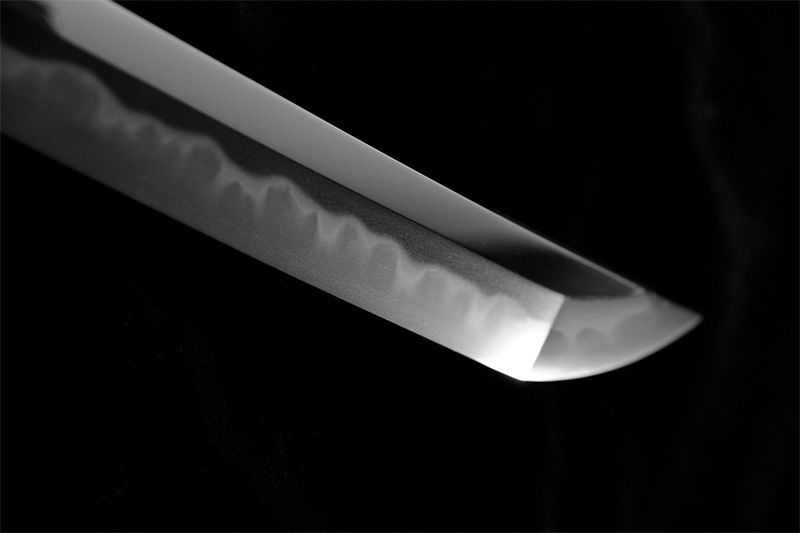 The clove-like hamon patterning of the blade is one of the characteristics of the Bizen tradition.
The clove-like hamon patterning of the blade is one of the characteristics of the Bizen tradition.
I studied for five years under Sumitani and for nine years with my father before establishing my own forge in the city of Tōmi in Nagano Prefecture. I received the mukansa qualification [meaning “exempt from examination,” it is the mark of a master craftsman] when I was 39, the youngest person at the time to do so. But as I entered my fifties, normally the prime of life for a swordsmith, I became seriously ill. I made up my mind that if I recovered I would not be shackled by traditions or schools.
My family has been making swords in the same tradition since the middle of the nineteenth century, but I broke away and become something of a lone wolf. My swords combine differing traditions with novel elements, and I think that fusion appeals to many of people.
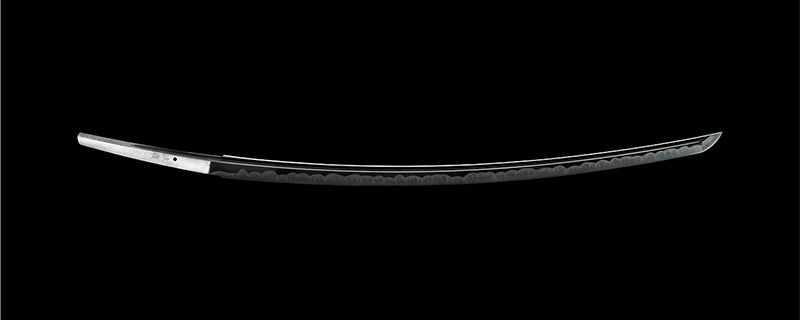 A dagger designed by Miyairi in a style designated as an intangible cultural heritage of Nagano Prefecture.
A dagger designed by Miyairi in a style designated as an intangible cultural heritage of Nagano Prefecture.
Weighty Weapons
INTERVIEWER In the past, most swords were either designed to be used as weapons or for enjoyment as art pieces. Although no one makes swords as weapons today, legends tell of samurai testing their swords by cutting down a passing peasant. Is there any truth to these stories?
MIYAIRI In the Sengoku period [1467–1603], warriors used to compete to see who had the sharpest sword by piling up bodies of executed criminals and seeing how many they could cut through. A sword that performed well would have its value and reputation enhanced. At other times, samurai would test a sword by slicing a cadaver in certain places from the feet to the head. The clavicle was considered the hardest part to cut, and if a sword passed through smoothly it would be recognized as an ōwazamono, one of the highest accolades for a blade.
Incidentally, in period dramas and movies you often see actors swinging their swords with one hand, but that’s only possible because they’re using replicas covered in thin metal plating. A real Japanese sword weighs anything from one to three kilograms, so it’s not something you can just lightly swing around your head. It’s not really the way samurai used to fight anyway. When samurai dueled, the slightest misstep could be fatal. They would sometimes face off for half a day, holding their swords at the ready and waiting for the perfect moment to strike, much like the legendary contest between the famous swordsmen Miyamoto Musashi and Sasaki Kojirō.
The Austere Beauty of Iron and Steel
INTERVIEWER Most famous swords are considered art pieces and crafted for their aesthetic qualities, not for their ability to cut. A certain amount of knowledge and discernment is required before a person can recognize the finer qualities of a great sword. Where does the beauty of the Japanese sword lie?
MIYAIRI The aesthetics for judging a Japanese sword are the quality of the metal itself, the hamon patterning that appears along the sword, and the overall form of the blade. In other parts of the world, swords were often decorated with intricate lacing and gems, and these were an important part of what made a sword valuable. But the beauty and artistic value of a Japanese sword lies in the steel itself.
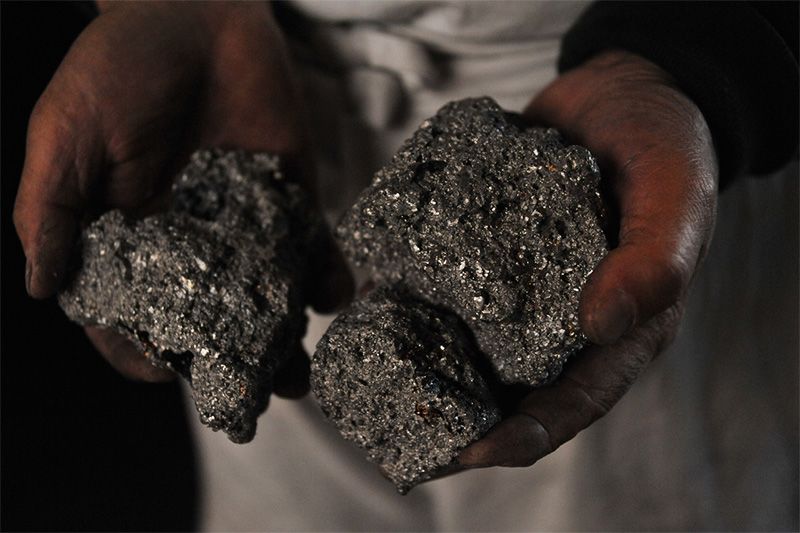 Japanese swords are forged from tamahagane (steel smelted from iron sand). The metal is tempered to distribute the carbon evenly, producing extremely strong steel.
Japanese swords are forged from tamahagane (steel smelted from iron sand). The metal is tempered to distribute the carbon evenly, producing extremely strong steel.
The three sacred treasures of Japanese mythology are a mirror, a jewel, and a sword. Japanese have long felt that gleaming objects hold mystical powers, and from early times people refined polishing techniques to a high level.
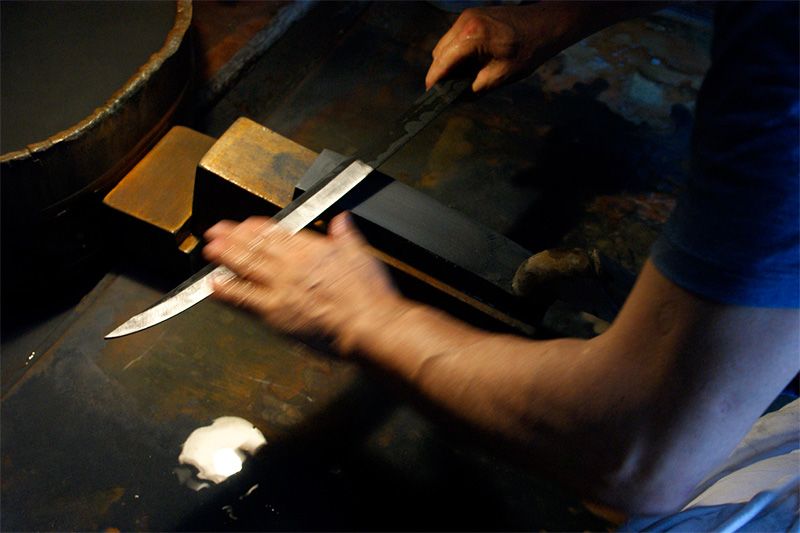 After firing, Miyairi polishes the sword on progressively smoother grades of stones.
After firing, Miyairi polishes the sword on progressively smoother grades of stones.
It’s certainly true that doing some study will help you better appreciate the subtle qualities of a sword. I have clients around the world who have studied the history and culture of Japanese swords and are very well informed about what goes into making a good piece.
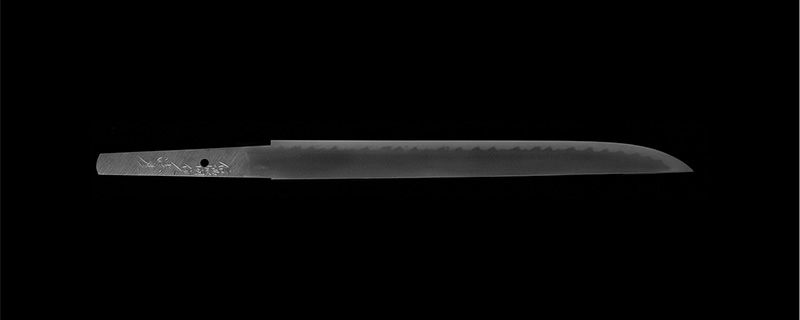 A tantō (short sword) made by Miyairi Norihiro. This masterpiece, with its translucent sheen, is reminiscent of the famous swords made by Bizen Osafune Kagemitsu, a great swordsmith of the Kamakura period (1185–1333).
A tantō (short sword) made by Miyairi Norihiro. This masterpiece, with its translucent sheen, is reminiscent of the famous swords made by Bizen Osafune Kagemitsu, a great swordsmith of the Kamakura period (1185–1333).
Little and Large
Apart from the bold world of the Japanese swords, Miyairi is the last remaining artisan capable of making a classical tōsu, an elegant small knife popular with Japanese nobility more than 1,000 years ago. These delicate stationery knives decorated with intricate chasing and bachiru, a craft of engraving dyed ivory, were favored accouterments at court in the Tenpyō era (729–749). Miyairi applies the same techniques used in classical times to make the decorative blades, single-handedly completing everything from the body of the blade to the filigree chasing.
INTERVIEWER What led you to divide your time between the dynamic, unadorned simplicity of the Japanese sword and the dainty, finely detailed ornamentation of the tōsu?
MIYAIRI A tōsu is extremely intricate and delicate. Working with something as exquisite as that enables me to look at swords with a finer eye for details. The nobility in the Tenpyō and subsequent eras would wear the blades as personal adornments, and people today often ask me to make an original tōsu for them to wear as a kind of lucky charm. I feel proud to be involved with this precious part of ancient Japanese culture and to help it to survive into the future.
In 2009, I was commissioned by the Shōsōin treasure house in Nara to produce a replica of a tōsu in its collection. Making a copy of such an ancient and intricately detailed treasure was no easy matter. First, I had to research and resurrect numerous forgotten techniques as well as learn precisely what materials were used to make the knife. Naturally, I took a scientific approach, but I also needed to learn to recognize the innate spirit the item possesses. As if all that wasn’t challenging enough, the Shōsōin is a highly secretive place, and it was out of the question for me to set up my tools and start working there. I didn’t have the original in front of me and so had to work from photographs. I traveled numerous times to Nara and spent hours intently studying the priceless, 1,200-year-old original trying to commit every detail of its appearance and aura to memory.
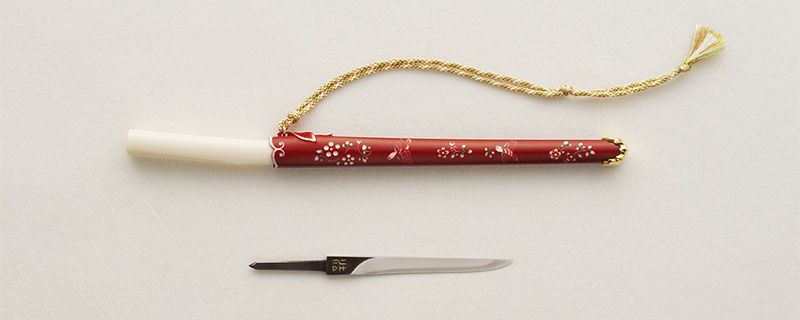 Bachiru is an ancient craft originating in Tang China of carving elegant patterns onto dyed ivory.
Bachiru is an ancient craft originating in Tang China of carving elegant patterns onto dyed ivory.
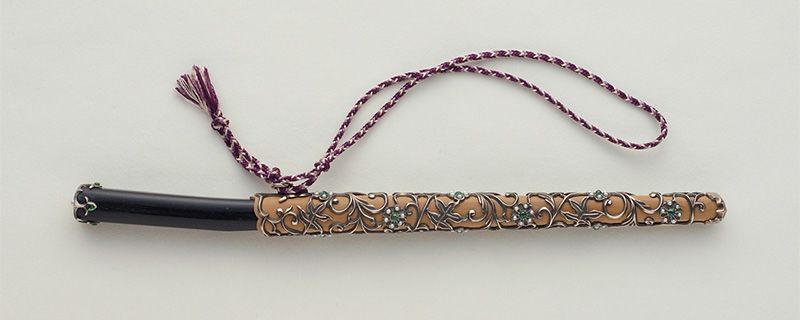 Miyairi made this tōsu for the Shōsōin treasure house in Nara. The finely carved ivy-like silver patterning incorporates 72 pearls and 16 emeralds.
Miyairi made this tōsu for the Shōsōin treasure house in Nara. The finely carved ivy-like silver patterning incorporates 72 pearls and 16 emeralds.
Recreating a Sword that Enchanted Japan’s Greatest Warriors
Miyairi has also made an exact replica of the Shokudaigiri Mitsutada (Mitsutada, the candlestick-cutter), a famous sword owned by the Mito branch of the famous Tokugawa family. The sword is said to have been a favorite weapon of some of the most celebrated warlords in Japanese history, including Oda Nobunaga, Toyotomi Hideyoshi, Date Masamune, and Tokugawa Mitsukuni. The name comes from a legend telling of Date Masamune cutting down one of his retainers with the sword and inadvertently severing a nearby candelabra cleanly in two. The sword was badly charred and its distinctive hamon patterning entirely lost in a fire following the 1923 Great Kantō Earthquake. Miyairi’s replica of this famous sword is now on display alongside priceless heirlooms at the Tokugawa Museum in Mito. The sword also appears in the sword-themed Tōken Ranbu game, which has been a major hit in recent years around the world, making Miyairi’s piece a popular attraction for fans of the game in Japan and overseas.
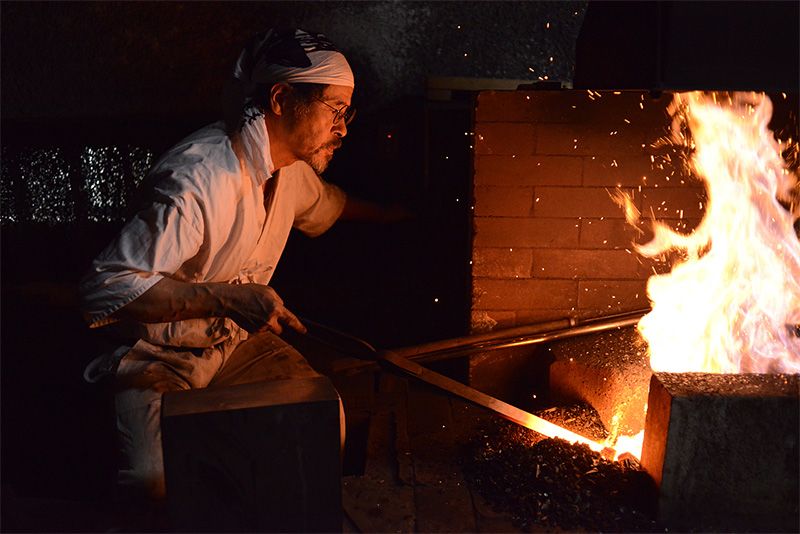 Miyairi quietly works alone at his forge. In summer, temperatures rise above 40 degrees Celsius.
Miyairi quietly works alone at his forge. In summer, temperatures rise above 40 degrees Celsius.
INTERVIEWER The legendary Shokudaigiri Mitsutada was charred beyond recognition nearly 100 years ago, and there are few reliable records showing what it originally looked like. You had to make a replica of the sword relying on the one picture that has survived. How did you approach such a daunting task?
MIYAIRI The decisive stage with a recreation job of this scale comes long before any questions of technique arise. You need to be able to make a sword that somehow embodies the original and is imbued with the same aura that you feel when you look at pictures in reference materials. This is not a logical or rational process. You don’t use your brain but surrender yourself to the task body and soul. The patterning that appears above the hamon is called utsuri [shadowing]—swords like this have not been forged since the early part of the fourteenth century.
It is thought that the original Shokudaigiri had its own distinctive utsuri before it was damaged. The first thing I had to do was to master that lost technique. Reproducing such a distinguished sword takes you into a realm that goes beyond technique. I had to let go and forget about my individuality as a swordsmith. In that sense, I had to take a totally different approach from when I make an original sword. Creating an acceptable replica of this famous sword was a long process of trial and error—but it turned out to be a rewarding and challenging process that has helped me expand and grow as an artisan.
(Originally published in Japanese on February 15, 2018. Interview and text by Kutsuwada Satsuki. Photos by Kimura Naoto. Banner photo: Miyairi Norihiro inspects a finished sword as it emerges from the forge.)